
Sager orphans
Encyclopedia
Oregon Trail
The Oregon Trail is a historic east-west wagon route that connected the Missouri River to valleys in Oregon and locations in between.After 1840 steam-powered riverboats and steamboats traversing up and down the Ohio, Mississippi and Missouri rivers sped settlement and development in the flat...
. During their journey both Naomi and Henry Sager lost their lives and left their seven children orphaned. Later adopted by Marcus
Marcus Whitman
Marcus Whitman was an American physician and Oregon missionary in the Oregon Country. Along with his wife Narcissa Whitman he started a mission in what is now southeastern Washington state in 1836, which would later become a stop along the Oregon Trail...
and Narcissa Whitman
Narcissa Whitman
Narcissa Prentiss Whitman was an American missionary in the Oregon Country of what would become the state of Washington. Along with Eliza Hart Spalding , she was the first European-American woman to cross the Rocky Mountains in 1836 on her way to found the Protestant Whitman Mission with husband Dr...
, missionaries in what is now Washington, the children were orphaned a second time, when both their new parents were killed during the Whitman massacre
Whitman massacre
The Whitman massacre was the murder in the Oregon Country on November 29, 1847 of U.S. missionaries Dr. Marcus Whitman and his wife Narcissa Whitman, along with eleven others. They were killed by Cayuse and Umatilla Indians. The incident began the Cayuse War...
in November 1847. About 1860 Catherine Sager, the oldest of the Sager girls, wrote a first-hand account of their journey across the plains and their life with the Whitmans. This account today is regarded as one of the most authentic accounts of the American westward migration.
The children's names were (from oldest to youngest):
- John Carney Sager (born 1831 in Union County, OhioUnion County, OhioUnion County is a county located in the US state of Ohio. As of the 2010 census, the population was 52,300. Increasingly becoming more of a suburban county, the population was estimated at 47,234 in 2007 by the U.S. Census Bureau...
) - Francisco "Frank" Sager (born 1833 in Union County, OhioUnion County, OhioUnion County is a county located in the US state of Ohio. As of the 2010 census, the population was 52,300. Increasingly becoming more of a suburban county, the population was estimated at 47,234 in 2007 by the U.S. Census Bureau...
) - Catherine Carney Sager (born April 15, 1835 in Union County, OhioUnion County, OhioUnion County is a county located in the US state of Ohio. As of the 2010 census, the population was 52,300. Increasingly becoming more of a suburban county, the population was estimated at 47,234 in 2007 by the U.S. Census Bureau...
) - Elizabeth Marie Sager (born July 6, 1837 in Union County, OhioUnion County, OhioUnion County is a county located in the US state of Ohio. As of the 2010 census, the population was 52,300. Increasingly becoming more of a suburban county, the population was estimated at 47,234 in 2007 by the U.S. Census Bureau...
) - Matilda Jane Sager (born October 6, 1839 in Buchanan County, MissouriBuchanan County, MissouriBuchanan County is a county located in the U.S. state of Missouri. As of 2010, the population was 89,201. Its county seat is Saint Joseph. When originally formed in 1838, the county was named Roberts County, after settler Hiram Roberts; it was renamed in 1839 for James Buchanan, then a U.S....
) - Hannah Louise "Louisa" Sager (born 1841 in Platte County, MissouriPlatte County, MissouriAs of the census of 2000, there were 73,781 people, 29,278 households, and 20,231 families residing in the county. The population density was 176 people per square mile . There were 30,902 housing units at an average density of 74 per square mile...
) - Henrietta Marie "Rosanna" Sager (born May 30, 1844 along the Oregon TrailOregon TrailThe Oregon Trail is a historic east-west wagon route that connected the Missouri River to valleys in Oregon and locations in between.After 1840 steam-powered riverboats and steamboats traversing up and down the Ohio, Mississippi and Missouri rivers sped settlement and development in the flat...
in present day KansasKansasKansas is a US state located in the Midwestern United States. It is named after the Kansas River which flows through it, which in turn was named after the Kansa Native American tribe, which inhabited the area. The tribe's name is often said to mean "people of the wind" or "people of the south...
)
Before the Oregon Trail
Henry Sager was described as a restless one by his daughter Catherine. Before 1844 Henry Sager had moved his growing family three times. Starting in VirginiaVirginia
The Commonwealth of Virginia , is a U.S. state on the Atlantic Coast of the Southern United States. Virginia is nicknamed the "Old Dominion" and sometimes the "Mother of Presidents" after the eight U.S. presidents born there...
they moved to Ohio
Ohio
Ohio is a Midwestern state in the United States. The 34th largest state by area in the U.S.,it is the 7th‑most populous with over 11.5 million residents, containing several major American cities and seven metropolitan areas with populations of 500,000 or more.The state's capital is Columbus...
, later to Indiana
Indiana
Indiana is a US state, admitted to the United States as the 19th on December 11, 1816. It is located in the Midwestern United States and Great Lakes Region. With 6,483,802 residents, the state is ranked 15th in population and 16th in population density. Indiana is ranked 38th in land area and is...
before finally arriving in Platte County, Missouri
Platte County, Missouri
As of the census of 2000, there were 73,781 people, 29,278 households, and 20,231 families residing in the county. The population density was 176 people per square mile . There were 30,902 housing units at an average density of 74 per square mile...
. There Henry Sager, backed by his two sons John and Francis (Frank) decided to head for Oregon
Oregon
Oregon is a state in the Pacific Northwest region of the United States. It is located on the Pacific coast, with Washington to the north, California to the south, Nevada on the southeast and Idaho to the east. The Columbia and Snake rivers delineate much of Oregon's northern and eastern...
, the fabled territory in the Pacific Northwest
Pacific Northwest
The Pacific Northwest is a region in northwestern North America, bounded by the Pacific Ocean to the west and, loosely, by the Rocky Mountains on the east. Definitions of the region vary and there is no commonly agreed upon boundary, even among Pacific Northwesterners. A common concept of the...
. Naomi was reluctant to go, at first, but eventually agreed. In late autumn 1843, the Sagers reached St. Joseph, Missouri, a jump-off point for the Oregon Trail
Oregon Trail
The Oregon Trail is a historic east-west wagon route that connected the Missouri River to valleys in Oregon and locations in between.After 1840 steam-powered riverboats and steamboats traversing up and down the Ohio, Mississippi and Missouri rivers sped settlement and development in the flat...
. At this time Naomi was already pregnant for the seventh time. Over the winter the family stayed in St. Joseph, Missouri where in March 1844 Henry Sager joined a group of pioneers who called themselves The Independent Colony.
On the Oregon Trail
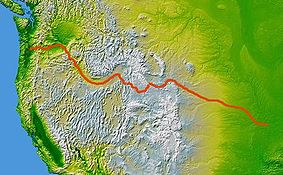
Conestoga wagon
The Conestoga wagon is a heavy, broad-wheeled covered wagon that was used extensively during the late 18th century and the 19th century in the United States and sometimes in Canada as well. It was large enough to transport loads up to 8 tons , and was drawn by horses, mules or oxen...
, crossed the Missouri River
Missouri River
The Missouri River flows through the central United States, and is a tributary of the Mississippi River. It is the longest river in North America and drains the third largest area, though only the thirteenth largest by discharge. The Missouri's watershed encompasses most of the American Great...
and started out on the 2000 miles (3,218.7 km) journey along the Oregon Trail. The company was under the command of Captain William Shaw, who himself was traveling with his wife Sally and six children. After five weeks on the trail Naomi gave birth to her seventh child, a baby girl named Rosanna. Due to the delivery, Naomi was weakened and only slowly regained her strength.
On July 4, 1844, the Independent Colony celebrated independence Day
Independence Day (United States)
Independence Day, commonly known as the Fourth of July, is a federal holiday in the United States commemorating the adoption of the Declaration of Independence on July 4, 1776, declaring independence from the Kingdom of Great Britain...
on the banks of the Platte River
Platte River
The Platte River is a major river in the state of Nebraska and is about long. Measured to its farthest source via its tributary the North Platte River, it flows for over . The Platte River is a tributary of the Missouri River, which in turn is a tributary of the Mississippi River which flows to...
. A couple of days later, while crossing the south fork of the Platte River, Naomi was severely injured as the Sager wagon overturned in the shallow waters along the river bank. But the pioneers pressed on. At the end of July 1844 the wagon train passed Chimney Rock
Chimney Rock National Historic Site
Chimney Rock is a prominent geological rock formation in Morrill County in western Nebraska. Rising nearly 300 feet above the surrounding North Platte River valley, the peak of Chimney Rock is above sea level. During the middle 19th century it served as a landmark along the Oregon Trail, the...
, a famous landmark along the trail in what is now Nebraska
Nebraska
Nebraska is a state on the Great Plains of the Midwestern United States. The state's capital is Lincoln and its largest city is Omaha, on the Missouri River....
. Chimney Rock was the reminder that the Great Plains
Great Plains
The Great Plains are a broad expanse of flat land, much of it covered in prairie, steppe and grassland, which lies west of the Mississippi River and east of the Rocky Mountains in the United States and Canada. This area covers parts of the U.S...
were almost crossed and the Rocky Mountains
Rocky Mountains
The Rocky Mountains are a major mountain range in western North America. The Rocky Mountains stretch more than from the northernmost part of British Columbia, in western Canada, to New Mexico, in the southwestern United States...
lay right ahead.
A few hours before reaching Fort Laramie
Fort Laramie National Historic Site
Fort Laramie was a significant 19th century trading post and diplomatic site located at the confluence of the Laramie River and the North Platte River in the upper Platte River Valley in the eastern part of the U.S. state of Wyoming...
, nine-year-old Catherine caught her dress on an axe handle when she jumped out of the moving wagon. Her leg got beneath one of the heavy wheels and was broken several times, an event that could have easily been fatal under the medical and sanitary conditions of that situation. But due to the immediate treatment by Henry Sager and Dr. Dagon, a German born doctor, the leg was eventually saved. Catherine however was confined to the wagon for the rest of the journey. From Fort Laramie onward, Dr. Dagon stayed with the Sagers in order to care for Catherine's injury. Thus the wagon train moved on and a couple of days later the Independent Colony reached Independence Rock
Independence Rock (Wyoming)
Independence Rock is a large granite rock, approximately high, in southwestern Natrona County in the U.S. state of Wyoming, along Wyoming Highway 220. During the middle of the 19th century, the rock was a prominent and well-known landmark on the Oregon, Mormon and California emigrant trails. It...
in present day Wyoming
Wyoming
Wyoming is a state in the mountain region of the Western United States. The western two thirds of the state is covered mostly with the mountain ranges and rangelands in the foothills of the Eastern Rocky Mountains, while the eastern third of the state is high elevation prairie known as the High...
, where some of the travelers carved their names into the granite
Granite
Granite is a common and widely occurring type of intrusive, felsic, igneous rock. Granite usually has a medium- to coarse-grained texture. Occasionally some individual crystals are larger than the groundmass, in which case the texture is known as porphyritic. A granitic rock with a porphyritic...
rock.
The death of Naomi and Henry Sager
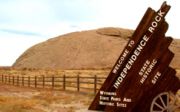
South Pass
South Pass is two mountain passes on the Continental Divide in the Rocky Mountains in southwestern Wyoming. The passes are located in a broad low region, 35 miles broad, between the Wind River Range to the north and the Oregon Buttes and Great Divide Basin to the south, in southwestern Fremont...
, a mountain pass that is part of the continental divide
Continental divide
A continental divide is a drainage divide on a continent such that the drainage basin on one side of the divide feeds into one ocean or sea, and the basin on the other side either feeds into a different ocean or sea, or else is endorheic, not connected to the open sea...
. During the descent into the Green River
Green River (Utah)
The Green River, located in the western United States, is the chief tributary of the Colorado River. The watershed of the river, known as the Green River Basin, covers parts of Wyoming, Utah, and Colorado. The Green River is long, beginning in the Wind River Mountains of Wyoming and flowing...
valley some of the travelers fell ill due to an outbreak of camp fever. Amongst those suffering from the fever was Henry Sager. After crossing the Green River, two women and a child were already dead, and it became evident that Henry Sager wouldn't live through the night. He asked Captain Shaw to take care for his family and died soon afterwards. He was buried by his family, on the banks of the Green River in an improvised coffin.
Naomi Sager, still weakened from child birth and mourning her husband, now had all the responsibility for the seven children. Although Captain Shaw and Dr. Dagon did everything possible to assist her, the exertions were too much. Suffering from heavy fever she became delirious and finally requested Dr. Dagon to squire the children to Dr. Marcus Whitman
Marcus Whitman
Marcus Whitman was an American physician and Oregon missionary in the Oregon Country. Along with his wife Narcissa Whitman he started a mission in what is now southeastern Washington state in 1836, which would later become a stop along the Oregon Trail...
, a missionary
Missionary
A missionary is a member of a religious group sent into an area to do evangelism or ministries of service, such as education, literacy, social justice, health care and economic development. The word "mission" originates from 1598 when the Jesuits sent members abroad, derived from the Latin...
in the Walla Walla Valley
Walla Walla River
The Walla Walla River is a tributary of the Columbia River, joining the Columbia just above Wallula Gap in southeastern Washington in the United States. The river flows through Umatilla County, Oregon and Walla Walla County, Washington. Its drainage basin is in area.-Course:The headwaters of the...
of what is now southeastern Washington. Naomi died near present day Twin Falls, Idaho
Twin Falls, Idaho
Twin Falls is the county seat and largest city of Twin Falls County, Idaho, United States. The population was 44,125 at the 2010 censusTwin Falls is the largest city of Idaho's Magic Valley region...
. Her last words were "Oh Henry, if you only knew how we have suffered". As there was no lumber available, Naomi was buried wrapped in a bedsheet. John, the oldest Sager orphan, carved the words Naomi Carney Sager, age 37 out of a wooden headboard and thus marked the shallow grave. The children—the youngest four months, the oldest thirteen years—were orphaned for the first time.
The Whitman years
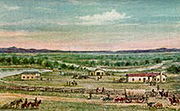
Walla Walla River
The Walla Walla River is a tributary of the Columbia River, joining the Columbia just above Wallula Gap in southeastern Washington in the United States. The river flows through Umatilla County, Oregon and Walla Walla County, Washington. Its drainage basin is in area.-Course:The headwaters of the...
. Narcissa suffered deeply from this loss. In an attempt to regain some sense of family she began taking care of other children. Soon four children were in the custody of the Whitmans, including the daughters of mountain men Joseph Meek
Joseph Meek
Joseph Lafayette "Joe" Meek was a trapper, law enforcement official, and politician in the Oregon Country and later Oregon Territory of the United States. A pioneer involved in the fur trade before settling in the Tualatin Valley, Meek would play a prominent role at the Champoeg Meetings of 1843...
and Jim Bridger
Jim Bridger
James Felix "Jim" Bridger was among the foremost mountain men, trappers, scouts and guides who explored and trapped the Western United States during the decades of 1820-1850, as well as mediating between native tribes and encroaching whites...
.
In early October 1844, the Independent Colony reached the Whitman Mission
Whitman Mission National Historic Site
Whitman Mission National Historic Site is a United States National Historic Site located just west of Walla Walla, Washington, at the site of the former Whitman Mission at Waiilatpu. On November 29, 1847, the family of Dr. Marcus Whitman and others were massacred by Native Americans of the Cayuse...
, and the Sagers found a new home with Narcissa. In July 1845 Dr. Marcus Whitman obtained a court order giving him legal custody of the children. The Sager orphans had new parents.
The deaths of Narcissa and Marcus Whitman
Dr. Marcus WhitmanMarcus Whitman
Marcus Whitman was an American physician and Oregon missionary in the Oregon Country. Along with his wife Narcissa Whitman he started a mission in what is now southeastern Washington state in 1836, which would later become a stop along the Oregon Trail...
was a physician
Physician
A physician is a health care provider who practices the profession of medicine, which is concerned with promoting, maintaining or restoring human health through the study, diagnosis, and treatment of disease, injury and other physical and mental impairments...
and a Protestant missionary. In 1836 he and his wife Narcissa, together with a group of other missionaries, joined a caravan of fur traders and traveled west, establishing several missions as well as their own settlement. Located in the Walla Walla Valley on the northern end of the Blue Mountains near the present day city of Walla Walla, Washington
Walla Walla, Washington
Walla Walla is the largest city in and the county seat of Walla Walla County, Washington, United States. The population was 31,731 at the 2010 census...
, their settlement was in the territory of both the Nez Percé and the Cayuse
Cayuse
The Cayuse are a Native American tribe in the state of Oregon in the United States. The Cayuse tribe shares a reservation in northeastern Oregon with the Umatilla and the Walla Walla tribes as part of the Confederated Tribes of the Umatilla Indian Reservation...
Native American tribes. The latter called it Waiilatpu (Why-ee-lat-poo, the 't' is half silent), which means "place of the rye grass" in the Cayuse language. Marcus farmed and provided medical care, while Narcissa set up a school for the Native American children. In the early days, life was peaceful at the Whitman Mission. But the peaceful coexistence of the local Cayuse and the white missionaries was in a delicate balance, and in 1847, three years after the arrival of the Sager orphans, the balance began to shift to distrust and animosity.
The number of wagon trains and pioneers had increased significantly since 1843. The settlers inadvertently brought with them disease
Disease
A disease is an abnormal condition affecting the body of an organism. It is often construed to be a medical condition associated with specific symptoms and signs. It may be caused by external factors, such as infectious disease, or it may be caused by internal dysfunctions, such as autoimmune...
s the Indians had no immunity to. In the fall of 1847 measles
Measles
Measles, also known as rubeola or morbilli, is an infection of the respiratory system caused by a virus, specifically a paramyxovirus of the genus Morbillivirus. Morbilliviruses, like other paramyxoviruses, are enveloped, single-stranded, negative-sense RNA viruses...
carried west with an emigrant train swept through the Cayuse villages. In the cold and damp weather of November 1847 the epidemic
Epidemic
In epidemiology, an epidemic , occurs when new cases of a certain disease, in a given human population, and during a given period, substantially exceed what is expected based on recent experience...
reached its peak and half the tribe died, including most of the children. On November 29, 1847 the situation erupted into violence. A man from the east named Joe Lewis, hoping to create a situation in which he could ransack the Whitman Mission, spread the rumor among the local Cayuse that Dr. Whitman, who was attempting to treat them during the epidemic, was in fact deliberately poisoning them. On November 29, 1847, the Cayuse attacked Waiilatpu.
The Whitman massacre
Whitman massacre
The Whitman massacre was the murder in the Oregon Country on November 29, 1847 of U.S. missionaries Dr. Marcus Whitman and his wife Narcissa Whitman, along with eleven others. They were killed by Cayuse and Umatilla Indians. The incident began the Cayuse War...
ended with the death of fourteen people at the mission, including Narcissa and Marcus Whitman and John and Francis Sager. Another fifty-four women and children were captured and held for ransom, including the daughters of Joseph Meek
Joseph Meek
Joseph Lafayette "Joe" Meek was a trapper, law enforcement official, and politician in the Oregon Country and later Oregon Territory of the United States. A pioneer involved in the fur trade before settling in the Tualatin Valley, Meek would play a prominent role at the Champoeg Meetings of 1843...
and Jim Bridger
Jim Bridger
James Felix "Jim" Bridger was among the foremost mountain men, trappers, scouts and guides who explored and trapped the Western United States during the decades of 1820-1850, as well as mediating between native tribes and encroaching whites...
and all the Sager girls. Several of the prisoners died in captivity, mostly from illnesses such as measles, including Helen Mar Meek and Hannah Louise Sager, aged 6. One month after the massacre, on December 29, 1847, Peter Skene Ogden
Peter Skene Ogden
Peter Skene Ogden , was a fur trader and a Canadian explorer of what is now British Columbia and the American West...
from the Hudson's Bay Company
Hudson's Bay Company
The Hudson's Bay Company , abbreviated HBC, or "The Bay" is the oldest commercial corporation in North America and one of the oldest in the world. A fur trading business for much of its existence, today Hudson's Bay Company owns and operates retail stores throughout Canada...
arranged an exchange of sixty-two blankets, sixty-three cotton shirts, twelve rifles, six hundred loads of ammunition, seven pounds of tobacco and twelve flints for the return of the forty-nine surviving prisoners. They were brought to Fort Vancouver
Fort Vancouver
Fort Vancouver was a 19th century fur trading outpost along the Columbia River that served as the headquarters of the Hudson's Bay Company in the company's Columbia District...
and released into freedom.
After the Whitman massacre
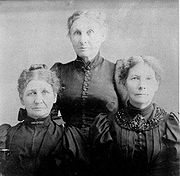
- Rosanna, the baby girl born on the Oregon Trail, had no children. She died at the age of twenty-six, mistakenly shot by an outlaw.
- Matilda had 8 children. She spent her later life with a daughter in California, where she died on April 13, 1928, at the age of eighty-nine.
- Elizabeth gave birth to 9 children. She lived in Portland, Oregon, where she died on July 19, 1925 at the age of eighty-eight.
- Catherine, the eldest of the Sager girls, married Clark Pringle, a Methodist minister and bore him 8 children. They lived in Spokane, WashingtonSpokane, WashingtonSpokane is a city located in the Northwestern United States in the state of Washington. It is the largest city of Spokane County of which it is also the county seat, and the metropolitan center of the Inland Northwest region...
. About ten years after her arrival in Oregon Catherine wrote an account of the Sager family's journey west. She hoped to earn enough money to set up an orphanage in the memory of Narcissa Whitman. She never found a publisher. Catherine died on August 10, 1910, at the age of seventy-five.
Her children and grandchildren saved her manuscript without modification, and it is today regarded as one of the most authentic accounts of the American westward migration.
In 1897, more than 3,000 visitors attended the 50th anniversary commemoration of the massacre on the mission grounds. Invited as guests of honor were some of the survivors of the events of 1847, including Catherine Sager Pringle, Elizabeth Sager Helm and Matilda Sager Delaney, the last survivors of the Sager orphans.
Sources
- Catherine Sager-Pringle, Across the Plains in 1844.
- National Park Service – Whitman Mission NHS, The True Story of the Sagers.
- Mary Trotter Kion, The Sagers go West.
- Erwin N. Thompson, Shallow Grave at Waiilatpu: The Sagers' West (1969).
- Ken Burns, The West, Transcript of the PBS documentary.
External links
- Catherine Sager-Pringle: Across the Plains in 1844
- The True Story of the Sagers National Park Service - Whitman Mission National Historic Site
- The Oregon Trail (Collection of historic sources of the Oregon Trail)
- http://www.over-land.com/diaries.html Diaries, memoirs, letters and reports along the trails west

